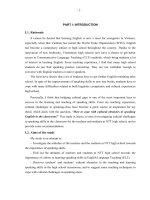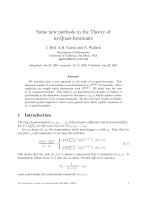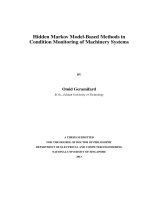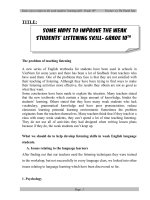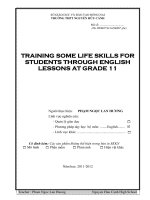SKKN THPT Some effective error correction methods in english articles of grade 10
Bạn đang xem bản rút gọn của tài liệu. Xem và tải ngay bản đầy đủ của tài liệu tại đây (156.17 KB, 16 trang )
"Some effective error correction methods in English articles of grade
10"
I. BACKGROUND
English is the most popular language in the world, an important school subject.
Recognizing the importance of this language in international communication as well
as in the development of international integration, the Vietnamese education industry
has chosen English as the leading subject. English is not only necessary for tourism,
foreign trade, foreign companies, computer users ... but also a compulsory high
school graduation exam. Therefore, every student in high school must have a certain
level of English to prepare for exams and after graduating, at least they must be able
to communicate, read and write some common texts. meet. In order to do this, we
constantly innovate teaching methods as well as curriculum to achieve real results for
English in general and to train some basic skills for students.
When learning a foreign language, writing skills are considered as one of the
important skills that learners need to master if they really want to succeed in
communication. Learning English is not an exception, especially during the opening
of international economic integration, when most of the information resources are
written in English, which requires increasing writing skills of this language. Writing
is a skill that everyone, regardless of the profession, will use every day. As students,
they have been and will encounter many types of writing to perfect their learning
process. However, according to Nunan: "In all skills, writing a coherent, fluent and
suggestive writing is the most difficult thing in language learning" (In terms of skills,
producing a coherent, fluent and extended piece of writing is probably the most
difficult thing there is to do in language).
In the process of learning a foreign language, making mistakes is also an
inevitable part and plays an important role. When practicing writing, students often
face many difficulties in writing paragraphs that are consistent and coherent. For 10th
graders who are just starting to get used to writing a short paragraph, it is essential to
point out the basic errors and guide them to fix them because it will help them
improve. in the process of learning and practicing writing skills later on.
Understanding the situations in which children make mistakes and how the teachers
and their students correct them will also help improve their writing skills. For English
teachers, who have the main responsibility to help students improve this skill, the
effectiveness of teaching depends not only on the method of teaching writing skills,
but also on knowledge and language skills. of the teacher. There are many factors that
affect the learner's writing results, error correction is an important factor among them.
We cannot deny that making mistakes in articles is inevitable during the learning
process. The more students pay attention to the lesson, the more they want to be
creative and develop in their own way of understanding language formation. This is
one of the reasons why the number of mistakes students make is increasing but
making mistakes is also seen as a positive process. From mistakes, learners can see
whether they write well or not and it also helps teachers assess the ability of students
at certain times to help them progress quickly. In the process of correcting errors,
teachers still encounter feedback from students. This means that there will be
disagreement not only with the teacher, but also within the student as to what errors
the students make, how to fix them, and whether corrective action will work in help
students improve their writing skills or not, how to fix errors most effectively, and fix
errors when it is reasonable.
With the problems encountered in teaching writing skills for 10th grade
students, I implemented the experience initiative in the 2017-2018 school year with
the subject: “Some effective methods of correcting errors in English articles Brother
of grade 10 student ”
By synthesizing, analyzing common mistakes in student writing and applying
some corrective methods, I hope to contribute to helping students understand the
difficulties in the learning process while suggesting Give teachers and students some
effective ways to correct mistakes to make the lesson achieve the desired results.
II. PROBLEM SOLVING
1. Rationale:
1.1. Write
1.1.1. The concept of "writing" in language theory
In order to have an appropriate and effective approach in teaching writing
skills, it is necessary to understand the concept of "writing" in language theory. There
are many definitions of "writing". Every linguist has his or her own definitions
depending on the criteria they consider important.
According to Byrne (1979), writing is "the operation of forming a sequence of
symbols arranged by convention to form words and words arranged into sentences".
From this perspective, we can see that any activity that makes up the word / sentence,
whether meaningful or not, is considered "written".
Writing, in terms of language theory, is not as simple as the concept that Byrne
came up with. It is a complex process that, according to Lannon (1989), defines "the
process of transforming materials discovered by inspiration, randomness, trial and
error or whatever is in the message. full meaning - Writing is a process of careful
decisions ”(p.9). According to this definition, writing must contain meaningful
messages, this definition is more complete than the definition of Byrne (1979)
because it aims to write, not write without clear direction.
In the process of teaching and learning, writing is considered to be a "language
skill" (Tribble, 1996, p.3), it is not only the presentation of language in written form
but also the development and expression of ideas in a sequential, structured way. ”It
is" a process that takes place over a period of time, especially when we spend some
time thinking before writing the first outline "(Harris, 1993, p.10). Compared to the
concepts given earlier, this concept is most satisfactory because it covers all aspects
of writing skills: form (written text), purpose (express ideas). , and structure
(textured).
When writing, we know that a written document is the product of an individual
with the purpose of communicating with others indirectly. That means the receiver
does not stand in front of the writer to hear from the writer. So the writer must make
sure the text he wrote is not only accurate but also easy to understand for the reader
Several factors that need to be considered when writing according to Raimes (1983)
CÚ PHÁP
NỘI DUNG
Cấu trúc câu
Sự thích hợp, rõ ràng,
v.v
logic, v.v.
NGỮ PHÁP
TIẾN TRÌNH VIẾT
Quy tắc thì,
Có ý tưởng, viết nháp
Mạo từ, đại từ, v.v.
kiểm tra lại
Những ý tưởng
rõ ràng và
HÌNH THỨC
hiệu quả
ĐỐI TƯỢNG
TIẾP NHẬN
Viết tay,
Người đọc
phát âm,
dấu câu, v.v
KẾT CẤU
MỤC ĐÍCH
Các đoạn văn,
Lý do viết
Chủ đề
Sự mạch lạc, thống nhất
SELECTION
Vocabulary, idioms, expressions
1.1.2. Writing process
According to Tribble (1996), the writing process consists of 4 steps:
1. Before writing: This is the step that the writer takes before drafting, including
selecting topics, thinking, taking notes, discussing, organizing ideas, drafting,
collecting information. (For example, interview, search library information, process
data).
2. Draft: Drafting is the process by which writers put ideas into sentences and
paragraphs, focusing on explanation, clarifying ideas, and linking ideas.
3. Revise: This is an important step for a complete document. The writer will think
about what the reader expects, the reader is the center of the text towards. For
example, refining texture, linking ideas or adding conjunctions.
4. Editing: The writer reviews the form of writing such as spelling, grammar and
punctuation.
As we see from the point of view, writing is a one-way process that does not
involve the reader. Reid (1993) makes the same point but adds three more steps to the
writing process: feedback, evaluation and after writing. This makes Reid's writing
process more satisfactory.
In short, the steps of the writing process according to Reid (1993) can be
illustrated in the following diagram:
TRƯỚC KHI VIẾT
VIẾT NHÁP
PHẢN HỒI
SỬA LẠI
BIÊN TẬP
ĐÁNH GIÁ
SAU KHI VIẾT
In short, writing is an exercise that two people don't do in the same way.
However, there are basic steps that every writer must follow when writing. Every
researcher has different ways to illustrate the writing process, but all of them
consistently write as a process of "recursive" rule, which requires great effort from
the writer.
1.2. The concepts of "error" and "error correction":
1.2.1. Overview of the error:
1.2.1.1. Concept:
There are many definitions of errors given by famous researchers such as
Abbort (1981), Edge (1989), McKay (1989), Goldstein (1990), Hubbard (1991),
Klassen (1993), Crosling. (1996) etc. Although they express in different ways, the
concepts have in common the nature and function of the error.
Goldstein (1990) defines errors as "an act of ignorance, omission, or
unintentional neglect, lost from the original orientation or failed to achieve the goal".
Klassen (1993) gives a simpler definition of error. According to Klassen, the
error is "a form or structure that indigenous people cannot accept because of
inappropriate use."
Meanwhile, Crosling (1996) put forward his views in the direction of
respectful of the criteria "Any deviation from the method compared to the ordinary is
considered a fault".
When it comes to errors, some researchers have the same opinion that not only
foreign language learners make mistakes but also native speakers. Indigenous peoples
often make mistakes at two levels of "morphological error" and "expression error",
the second one is a common error with higher frequency (McKay, 1984). Therefore,
errors should be considered as unconventional and inappropriate things. We can see
mistakes at all levels of language, from form errors to expressions.
1.2.1.2. Error classification
Lippman, J. (2003) classifies errors into two categories: "general error"
(covering error) and "specific error".
PHÂN LOẠI ?
Vấn đề chung bao gồm:
Lỗi bao trùm
Lỗi riêng
1. Luận điểm
Không chính
không chính
2. Cấu trúc
xác toàn câu ,
xác từng thành tố
3. Căn cứ
VD. trật tự từ,
VD. thì,
4. Sự tương thích và nhất quán
liên từ
mạo từ,
5. Sự phù hợp với đối tượng và mục
không đúng
trợ động từ
đích
Vấn đề riêng bao gồm:
1. Chính tả
Kết quả
Kết quả
2. Cú pháp
Giao tiếp
Giao tiếp
3. Ngữ pháp
không thành công
khó hiểu
4. Dấu câu
Trích theo Lippman (2003)
There are many ways to classify errors depending on the purpose of the
researcher in the analysis and the appropriateness with the actual conditions of the
language teaching and learning.
1.2.2. Overview of error correction:
1.2.2.1. Error correction:
When evaluating an article we have the concept of "feedback" - feedback,
which has two elements to distinguish: "assessment" - evaluation and "correction" error correction. In terms of assessment, learners are simply identified as performing
well in the written article. Regarding error correction, learners receive detailed
information about the article such as: explanation, providing better ways of writing.
As a rule, correcting errors can and should give the writer the right and wrong way
and why, but in general both teachers and learners see this concept as correcting
errors.
1.2.2.2. Some basic methods of curing writing for students
In the process of teaching in general, teachers often have to solve problems such as
"which errors need fixing" and "fix errors effectively".
Gower and Walter (1983) presented four problems for language teachers to solve
when students made mistakes in writing, which is "what to fix, when, how and how
much".
Meanwhile, Raimes (1983) also introduced 7 basic principles of error
correction for error correction during classroom teaching:
1. For students' writing, there is no need to mark errors but still identify errors to be
corrected.
2. Identify the error carefully and find the cause.
3. Find the parts that students have successfully completed.
4. Record the students' mistakes
5. Set up error symbols that are clear and easy to understand.
6. Regularly give reasons or correct and remove errors carefully.
7. Finally: handle errors carefully and create habits for students.
Solving the problem of "fixing what, when", researchers often suggest that the
teacher should choose to fix the way immediately or until similar errors occur in the
same lesson.
To make the problem of "how much to fix" it is clear that Gower and Walter
offer some suggestions:
• Engage students in the writing process.
• Spend less time fixing individual mistakes but focusing on common mistakes.
• Identify errors students have made.
• Indicate the location of the error
• Indicate the type of error
• Give learners the opportunity to correct themselves
• Students who cannot fix the lesson, ask other students for help.
• If the previous step fails, the teacher corrects the error.
Edge (1989) also offers the following three basic troubleshooting steps:
(i) Self-correction - Self-correction:
Teachers point out errors for students to correct themselves because sometimes
students need help to identify errors before they correct themselves.
(ii) Peer correction - Learner corrects errors together:
Students work in pairs or in groups to find and correct errors in each other's
writing. This attracts all students to the process of error correction, making them
more active, less dependent on the teacher.
(iii) Teacher correction - correction teacher:
The teacher finds the writer who wants to say the wrong sentence and teaches
students how to express it correctly.
1.3. The relationship between error, error correction with the process of teaching and
learning writing skills
Making mistakes is inevitable in the learning process, in this way learners
create important and essential characteristics for language learning. Making mistakes
is the way a learner verifies what he or she has learned, capturing that language.
For teachers, making mistakes in the learning process helps them assess their
knowledge level, consider what they need to learn to improve.
Error correction also has a positive impact on the language teaching and
learning process. Students who learn through self-correction, correct mistakes made
by their classmates, and listen to their teachers' mistakes can progress faster.
Especially writing skills require high accuracy in words and expression.
2. Actual situation:
From analyzing survey data and reading and finding errors in student writings
during the course of teaching, we see some realities of the issues raised in this
experiential initiative as follows:
Both teachers and students have a positive attitude towards correcting errors,
and treat error as an essential part of the learning process, as an important factor in
improving students' writing ability.
Although error correction plays an important role in writing skills, and
although both teachers and students have tried, students' writing skills have not
improved much. The reason is that many errors have not been pointed out and
thoroughly corrected after making a general assessment of the student's writing, so
even if students review it, they can not understand where they are wrong.
There are errors that both teachers and students find difficult to make, such as
logical errors, word errors, or word errors. (Example: Correct sentence: I like reading
historical magazine. Wrong sentence: I like reading historic magazine. The adjective
historic - famous, important in history and historical - belongs to history.) Students
and teachers often pay attention to spelling, grammar or structure errors when
evaluating articles.
In the way of error correction method, both teachers and students think that the
teacher corrects errors, students correct students' mistakes and self-rectify is the main
method. Students are often passive in the process of correcting errors.
In general, there are still many problems in correcting students' essays,
especially 10th graders who are familiar with the types of writing in the curriculum
such as letters, invitations, narratives, etc. Therefore, in order to improve the quality
of teaching and learning in general as well as improve the effectiveness of error
correction in the learning process of writing, the introduction of effective and
appropriate error correction methods should be understood and applied.
3. Measures taken to solve the problem:
3.1. Teacher
3.1.1. Steps in the assessment process for student writing
3.1.1.1. Determine "Which errors need fixing"
Correcting all errors in a student's writing is not really necessary. Teachers
should choose important points - this depends on the language goal the lesson is
directed at. This requires the teacher to identify errors in the overarching or minor
errors and guide the students.
When students understand the common types of errors they will identify the
type of errors in their writing. It is often easier for students to find grammatical errors
than semantic errors, words or logic errors.
3.1.1.2. Determine "How many errors should be fixed"
The teacher may decide to correct only basic and serious errors so as not to
discourage students from having too many errors in their writing. However, the
amount of error that should be corrected depends on the student. Because some
students are embarrassed to have received too many errors in writing, others are not
satisfied if the article recognizes only a general comment such as a "good test".
3.1.1.3. Establishment of "Error remedy"
- Use symbols when fixing lessons: This method proves to be convenient because
teachers do not have to write all the words and phrases in the article, especially when
the number of lessons is high.
Symbols and meanings:
GR: Grammar - Grammar
Voc: Vocabulary - Vocabulary
Sp Spelling error - Spelling
P Punctuation error - Punctuation error
V Verb tenses errors - Error about
W.O Wrong word order - Wrong word order
W. Wrong word used - Using the wrong word
Agr Agreement - Agree
Y upside down (reverse y) word missing - Missing word
! Careless error - Careless error
Good, well done - Good work
? I Don't understand
Prep Preposition - Prepositions
Good point - Yes / good
Cap Capitalizing this word - Capitalization error
() Unnecessary word - Unnecessary words
Φ Omitting this word - Abandon this word
- Give feedback carefully: Giving feedback plays an important role in encouraging
students to read through the lesson and be more studious during learning. In addition
to pointing out mistakes, teachers should encourage and praise what students are
trying to show in the writing.
- Use a pen other than ink: Teachers often use a red pen when fixing lessons to make
them easier for students to see. But if a teacher uses a red pen to cross out any
mistakes in the writing, the students will look overwhelmed and disappointed, which
will make them feel that they cannot write well and that they do not want to have to
accept the writing. as a result, they no longer want to write. Correcting the writing is
not merely about pointing out the wrong thing but also encouraging students to
express and correct the mistakes themselves. The teacher should use a pen other than
the ink of the article to correct it or use a pencil to correct the lesson to help students
understand that the teacher is giving suggestions.
- Check the margin of the article for students to identify mistakes: This method
applies when students are familiar with the error signs. Students can find the errors
themselves in lines or sentence signs.
3.1.2. Steps after evaluating student writing
3.1.2.1. Organize general comments after marking
Students will learn more if teachers have time to correct their classwork after
grading. Students can avoid making similar mistakes in their writing when listening
to comments on other articles. There are errors in the expression that the teacher
could not write in the article, so in the process of remedying the student will hear
more.
3.1.2.2. Provide students with basic writing principles and exercises related to
students' common mistakes
The teacher may provide short memos (such as the structure of writing a letter
of direction that invites you to the play house) or the problem finding exercises for
students to practice.
3.2. The student
3.2.1. Change students' attitudes with error correction:
In the past, many teachers thought that making mistakes was a bad thing. To
them, it indicates that the student is ignorant or lazy, and in some cases the teacher
blames the student for not paying attention or doing homework carefully. The teacher
may just say "Sit down" and not pay attention to the student as if he or she did
something wrong.
However, according to the new approach, students make mistakes that means
they are trying to find new expressions, they learn theories combined with practice.
Writing is a process and cannot ask the right student from the beginning. Must make
students understand error correction as one of the ways to help them improve skills, is
an important and useful part of the learning process. This helps students feel more
confident and balanced before going into writing.
3.2.2. Emphasize the importance of proofreading and correcting errors
Error correction is required, it is not a problem. Students need to see it as an
essential need while learning writing skills. Correcting errors when students try their
best to write often does not encourage students. The appropriate solution is to turn
error correction into activity in the classroom. Involving students in the writing
process is another way to encourage students to use English without worrying about
making mistakes. Raising students' awareness of proofreading and correcting errors
will help them pay more attention to correcting their own writing and yours. To help
students raise awareness, teachers themselves need to be aware and set some rules
when discussing, which can give extra points for students to have accurate comments
on your writing in the past. class curing program.
3.2.3. Instruct students on how to find and point out errors
• Using an error correction system is really effective, which encourages students to
correct their own problems and correct other students' problems. Teachers need to
give clear instructions and notation systems at the beginning of writing.
• Example: Find and point out errors in Jack Friedhamm's biography article
Correct post:
Jack Friedhamm was born in New York on October 25, 1965. He began school
at the age of six and continued until he was 18 years old. He then went to New York
University to learn Medicine. He decided on Medicine because he liked biology when
he was at school. While he was at University, he met his wife Cindy. Cindy was a
beautiful woman with long black hair. They went out for years before they decided to
get married. Jack began to work as a doctor as soon as he had graduated from
Medical School. They have had two children named Jackie and Peter, and have lived
in Queens for the past two years. Jack is very interested in painting and likes to paint
portraits of his son Peter.
3.2.4. Apply drafting activities repeatedly
Repeated drafts are considered an effective way to correct errors. This method
motivates students to participate in the correction process. To perform this operation
need to follow some steps:
Instruct students to look for errors in each draft:
In this activity, students are asked to write 3 copies so that the final version is
as complete as possible. Each time, students need to pay attention to the types of
errors according to the following table:
Lần 1
Lần
3rd version
Lỗi cần Kiểm tra cấu trúc và Chú ý đến cách dùng Tìm tất cả các lỗi có
chú ý
logic của bài viết
từ,
ngữ
pháp,
hình thể
thưc…
Grading plus students who are able to find and point out errors in papers.
The plus point can encourage students to engage in error correction activities to
help you perfect your writing.
Assess student progress through each draft paper:
Teachers can also see students' progress through each article, and can also give
points to students who show significant changes.
4. The effectiveness of experience initiatives:
The experiential initiative is implemented to point out and analyze some
common mistakes for 10th grade students while learning writing skills, as well as
provide some effective error correction methods for teachers during careful
instruction. writing ability.
Actual teaching in the 2011-2012 school year tests the writing skills of students
in grades 10A4 at the beginning of the semester compared to the end of the semester.
Test your writing skills with a quiz 20 minutes after you finish Unit 1 A day in the life
of ... - write a paragraph of 100 -120 words about your daily activities (Your daily
activities). The analysis results of the following errors:
Lỗi
0-4 lỗi
5-8 lỗi
9-12
Trên 12 lỗi
Ngữ pháp
3 h/s
12h/s
12h/s
15h/s
Từ vựng
9h/s
11h/s
12h/s
10h/s
Chính tả
5h/s
12h/s
15h/s
10h/s
Analyzing data shows that at the beginning of grade 10, students' writing skills
are uneven and weak with a rate of more than 50% with 9 errors. Especially, the
writing results of the writing show that only 25% of students achieved above average
results.
Test the skill of finding errors by finding and correcting errors for 10 sentences in 15
minutes with 15 students at different levels according to the test results, the results are as
follows:
Học sinh
Yếu
TB
Khá/ giỏi
Phát hiện 1-4 lỗi
5/5 h/s
3/5 h/s
2/5 h/s
Phát hiện 5-8 lỗi
0/5 h/s
2/5 h/s
3/5 h/s
Phát hiện 9-10 lỗi
0/5 h/s
0/5 h/s
/5 h/s
Through testing we find that the skill of finding and correcting errors does not
entirely depend on the grammar and vocabulary base but due to the ability to apply
that language into practice.
During the writing lessons in the first semester, applying the methods
mentioned in Part 3 of SKKN, students' ability to find and correct errors has
improved significantly through each test during the learning process.
The error-finding skill "Error Identifitaction" among 42 students tested with
70% h / s found that more than 50% of the errors in the article were required to find
errors.
Writing skills through group activities, 50% of students in the group have the
ability to correct the group's writing during the discussion.
The results of the tests after the writing period of 5 students or any group in
Semester I (40 articles) are as follows:
Lỗi
Ngữ pháp
Từ vựng
Chính tả
0-4 lỗi
15 bài
15 bài
17 bài
5-8 lỗi
15 bài
17 bài
12 bài
9-12
5 bài
2 bài
8 bài
Trên 12 lỗi
5 bài
3 bài
3 bài
The results of practicing the writing skills of students 10 A4 after 8 periods of
writing of the school year 2017 - 2018 have not really reached the perfection level
because students of 10A4 are students in block C, not paying much attention to
English. However, it is initially found that if actively changing the content as well as
the method of teaching foreign languages, it will bring certain effects and realize the
ultimate goal of language learning that is to use the language in the language. life and
work.
III. CONCLUSIONS AND RECOMMENDATIONS
1. Conclusion
Writing is one of the most important language skills for English learners,
perfecting it requires a lot of time and effort. The problem for both teachers and
students in the learning process is finding effective teaching and practicing writing
skills. On the other hand, you can realize that making mistakes is inevitable and plays
an important role in language learning. Errors in the learning process are considered
positive steps, whereby students gain more experience, awareness and make certain
progress.
The implementation of the experiential initiative with the above mentioned
goals provided some effective remedies for students in the English program 10. With
teaching, I see this initiative as a motivation. help me and my colleagues to be more
creative in teaching because teaching English writing skills in high school English is
not a simple job, requires a lot of effort to explore and be patient. The results cannot
be seen overnight but take a relatively long time.
The scope of application of this initiative can be extended to all English
learners of all grades because of the writing skills and error correction requirements
are included in all lesson units in the textbook.
2. Recommendations:
In order to succeed in helping students correct errors in writing to perfect their
writing skills, it is indispensable for the enthusiasm, love of the job and professional
qualifications of teachers. Besides, there should be support, encouragement, attention
and prompt guidance of the school and the leadership.
In the next school year, I have the desire to implement an experience initiative
to add some writing skills to the elective curriculum to teach enriching and intensive
writing skills.
The above is all that I have done and learned from my teaching experience.
However, the topic may not avoid limitations that need to be added.
Looking forward to the comments of colleagues to make my seminar more
complete!
